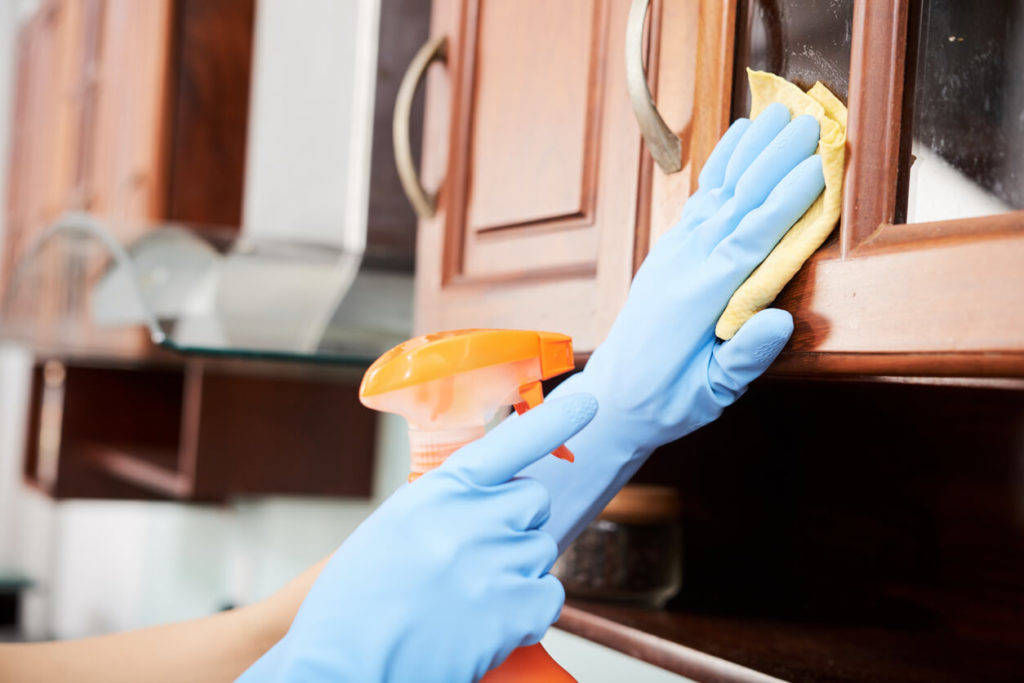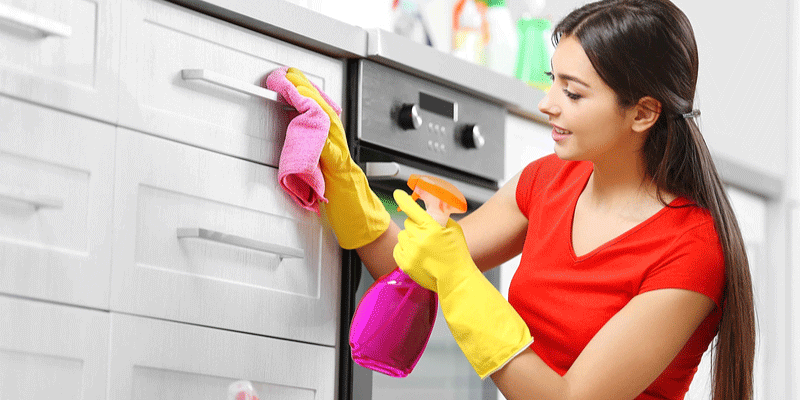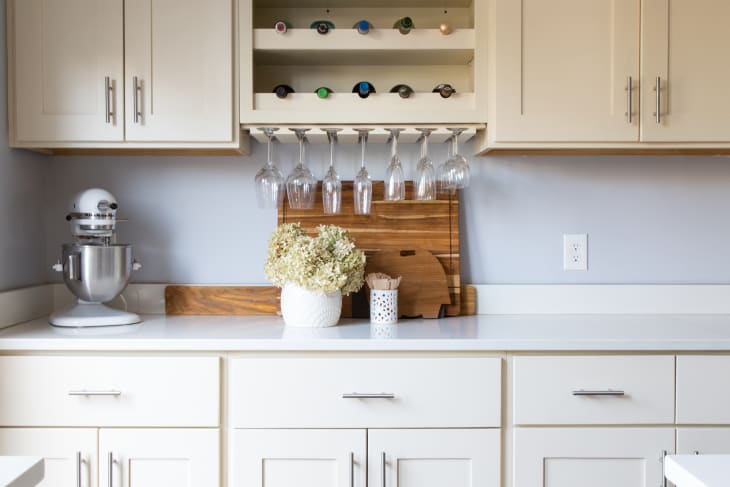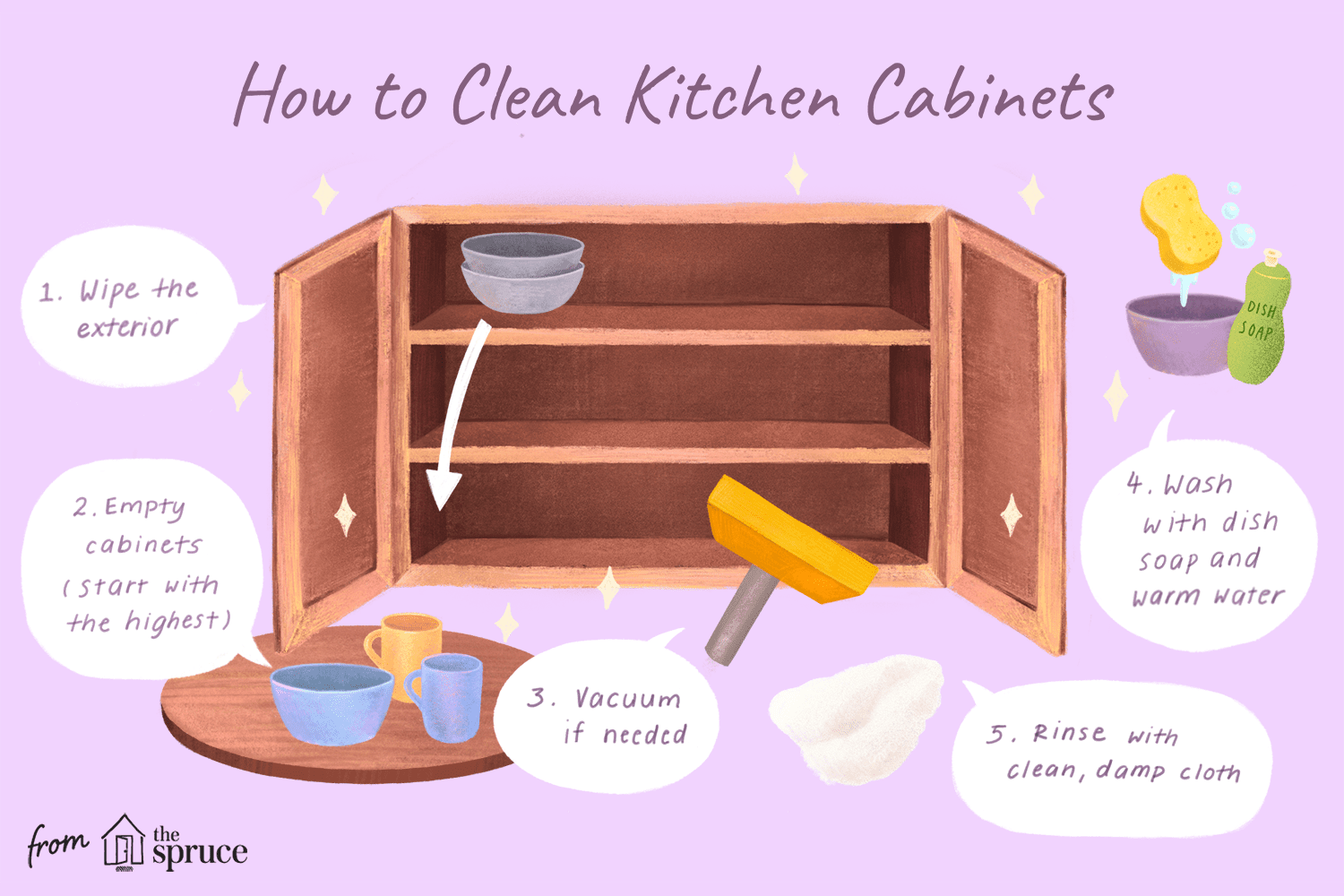Kitchen cabinets should be cleaned every two weeks. Deep cleaning should be done every three to six months.
Maintaining clean kitchen cabinets is essential for a hygienic cooking environment. Cabinets often accumulate grease, dust, and food particles. Regular cleaning prevents buildup and keeps your kitchen looking fresh. Use a damp cloth for routine cleaning every two weeks. For deep cleaning, use a mild detergent and warm water every three to six months.
This removes stubborn grime and extends the life of your cabinets. Always dry surfaces thoroughly to avoid damage. Consistent maintenance not only enhances kitchen aesthetics but also promotes a healthier space for meal preparation. Follow these cleaning tips to ensure your kitchen remains spotless and inviting.

Credit: www.bbifinishes.com
Table of Contents
ToggleImportance Of Clean Kitchen Cabinets
Keeping your kitchen cabinets clean is crucial. It impacts both health and aesthetics. Clean cabinets ensure a hygienic environment and enhance your kitchen’s look. Let’s dive into the importance of clean kitchen cabinets.
Health Benefits
Clean kitchen cabinets help prevent the buildup of germs and bacteria. This is essential for maintaining a healthy kitchen. Dirty cabinets can harbor harmful microorganisms that contaminate food. Regular cleaning reduces the risk of foodborne illnesses. Additionally, it helps control allergens like dust and mold. This is especially important for those with allergies or asthma.
| Benefit | Description |
|---|---|
| Reduce Germs | Prevents the spread of harmful bacteria. |
| Control Allergens | Minimizes dust and mold buildup. |
| Prevent Contamination | Ensures food safety by reducing contamination risks. |
Aesthetic Appeal
Clean cabinets make your kitchen look inviting and well-maintained. Aesthetically pleasing cabinets can uplift the entire kitchen’s look. They create a positive impression on guests and potential buyers. Dirty or greasy cabinets can make the kitchen appear neglected. Regular cleaning helps in maintaining the cabinets’ original shine and finish.
- Enhances kitchen’s overall look
- Creates a welcoming environment
- Maintains the original shine and finish
- Leaves a positive impression on guests
Both health benefits and aesthetic appeal make cleaning kitchen cabinets essential. Regular maintenance ensures a safe and beautiful kitchen environment.
Factors Influencing Cleaning Frequency
How often should you clean your kitchen cabinets? The answer depends on several factors. These include how you use your kitchen and the materials of your cabinets. Let’s explore these factors to help you decide.
Usage Patterns
How often you use your kitchen plays a big role. If you cook daily, your cabinets will get dirty faster. Grease, food splatters, and fingerprints build up quickly. Busy kitchens need more frequent cleaning.
- Daily Use: Wipe down cabinets weekly.
- Occasional Use: Clean cabinets every two weeks.
- Rare Use: Monthly cleaning should be enough.
Also, consider the number of people in your household. More people mean more usage. More usage means more dirt and grime.
Type Of Material
The material of your cabinets affects cleaning frequency. Different materials need different care. Let’s look at some common materials.
| Material | Cleaning Frequency |
|---|---|
| Wood | Clean every week to prevent buildup. |
| Laminate | Wipe down every two weeks. |
| Painted | Check weekly for stains and clean as needed. |
| Stainless Steel | Clean weekly to avoid fingerprints and smudges. |
Wood cabinets need more care to keep them looking good. Laminate is easier to clean but can stain. Painted cabinets require regular checks for marks. Stainless steel shows fingerprints easily, needing frequent wiping.
Understanding these factors helps you keep your kitchen clean and beautiful. Regular cleaning based on your usage and material type ensures longevity and hygiene.
Daily Maintenance Tips
Keeping your kitchen cabinets clean is essential for maintaining a healthy home. Daily maintenance helps prevent the buildup of grease, grime, and food particles. Here are some simple daily maintenance tips to keep your kitchen cabinets looking their best.
Quick Wipe-down
Perform a quick wipe-down of your kitchen cabinets daily. Use a soft microfiber cloth for this task. Lightly dampen the cloth with warm water and mild dish soap. Wipe the cabinet doors, handles, and edges. This removes dust, fingerprints, and minor spills.
Avoid soaking the cloth, as too much water can damage the cabinet finish. Pay special attention to high-touch areas like handles and knobs. This simple act keeps your cabinets looking fresh and clean every day.
Handling Spills
Spills happen, especially in the kitchen. Clean spills immediately to prevent stains and sticky residue. Use a soft cloth or paper towel to blot the spill. Avoid rubbing, as this can spread the mess further.
For sticky or greasy spills, use a mild dish soap mixed with warm water. Dampen a cloth with the soapy water and gently clean the spill area. Dry the area with a clean, dry cloth to prevent water spots or damage.
Taking care of spills right away keeps your cabinets in top condition. This daily habit ensures a spotless and hygienic kitchen.

Credit: topscabinet.net
Weekly Cleaning Routine
Maintaining clean kitchen cabinets is essential for a tidy kitchen. A weekly cleaning routine ensures your cabinets stay spotless and damage-free. This also prolongs their lifespan and keeps your kitchen hygienic.
Surface Cleaning
Start by removing any items from your cabinet surfaces. Use a soft cloth and a mild detergent solution. Wipe down the exterior surfaces thoroughly. Ensure you clean all visible areas, including handles and knobs.
Pay special attention to corners and edges. These areas often accumulate dirt and grime. If you encounter sticky residues, a little vinegar mixed with water helps. For wooden cabinets, a wood cleaner keeps the surface polished and protected.
Inspecting For Damage
While cleaning, inspect your cabinets for any signs of damage. Look for cracks, peeling, or discoloration. Early detection of issues prevents further damage.
Check the hinges and handles for loose screws. Tighten them if necessary. This ensures the cabinet doors function properly. Also, look for any signs of moisture damage, especially around the sink area.
Regular inspections help you maintain the quality and appearance of your kitchen cabinets. A well-maintained cabinet not only looks good but also lasts longer.
Monthly Deep Cleaning
Keeping your kitchen cabinets clean is essential for maintaining a hygienic kitchen. A monthly deep cleaning ensures that your cabinets remain free from dust, grime, and potential pests. This process involves a thorough cleaning session, focusing on both the interior and exterior of your cabinets.
Removing Items
Start by removing all items from your cabinets. This includes dishes, pots, pans, and food items. Place them on your countertop or table.
| Steps | Action |
|---|---|
| 1 | Empty each cabinet completely. |
| 2 | Sort items into categories (e.g., dishes, spices). |
| 3 | Check for expired food items and dispose of them. |
Cleaning Inside Cabinets
Once the cabinets are empty, it’s time to clean the inside. Use a mild cleaner or a mixture of vinegar and water.
- Spray the cleaner inside the cabinet.
- Use a soft cloth or sponge to wipe down surfaces.
- Pay attention to corners and edges where dust gathers.
For stubborn stains, apply baking soda to a damp cloth and scrub gently. After cleaning, ensure the cabinets are completely dry before placing items back inside.
By following these steps, your kitchen cabinets will stay clean and organized. Regular maintenance helps in extending the lifespan of your cabinets and keeps your kitchen looking fresh.

Credit: www.thekitchn.com
Seasonal Cleaning Tasks
Seasonal cleaning tasks are essential for maintaining the longevity and appearance of your kitchen cabinets. By performing these tasks, you ensure that your kitchen stays hygienic and organized. Let’s explore some critical seasonal cleaning tasks for your kitchen cabinets.
Decluttering
Decluttering your kitchen cabinets helps in keeping them organized and efficient. Start by taking everything out of the cabinets.
- Sort items into categories: keep, donate, or dispose of.
- Wipe down the shelves with a damp cloth.
- Use shelf liners to protect cabinet surfaces.
- Reorganize items in a logical manner.
Keeping your cabinets clutter-free makes them more functional and pleasant to use. Regular decluttering prevents the buildup of unnecessary items.
Checking Hinges And Handles
Hinges and handles are essential components of your kitchen cabinets. Regular checks help maintain their functionality.
| Task | Frequency |
|---|---|
| Inspect hinges for rust or damage | Every 3 months |
| Tighten loose screws on handles | Every 6 months |
| Lubricate hinges | Annually |
Performing these checks ensures that your cabinet doors open and close smoothly. Tightening screws and lubricating hinges extend the life of your cabinets.
By incorporating these seasonal tasks, you keep your kitchen cabinets clean and functional. Regular maintenance is the key to a well-organized kitchen.
Cleaning Products And Tools
Keeping your kitchen cabinets clean is essential for a healthy home. Using the right cleaning products and tools can make this task easier and more efficient. In this section, we will cover the recommended cleaners and essential tools you need.
Recommended Cleaners
Choosing the right cleaner is crucial for maintaining your kitchen cabinets. Here are some top recommendations:
- Mild Dish Soap: Mix a few drops with warm water. It’s gentle and effective.
- Vinegar Solution: Combine equal parts vinegar and water. Great for cutting grease.
- Baking Soda Paste: Mix baking soda with water to form a paste. Ideal for tough stains.
- Commercial Cleaners: Use products designed for wood or laminate surfaces. Ensure they are non-abrasive.
Essential Tools
Having the right tools can make cleaning your kitchen cabinets a breeze. Here is a list of essential tools you should have:
| Tool | Usage |
|---|---|
| Microfiber Cloths | For wiping surfaces without scratching them. |
| Soft Sponge | For scrubbing without damaging the finish. |
| Old Toothbrush | For cleaning crevices and detailed areas. |
| Spray Bottle | For applying homemade cleaning solutions. |
Using the right cleaning products and tools ensures your kitchen cabinets stay in top condition. Regular cleaning helps maintain their appearance and extends their life.
Common Mistakes To Avoid
Keeping your kitchen cabinets clean is essential for a hygienic home. Yet, there are common mistakes that people make during this process. These errors can damage your cabinets or make cleaning inefficient. Let’s explore some of the most frequent mistakes and how to avoid them.
Using Harsh Chemicals
Many people use strong cleaning agents on their cabinets. This can cause more harm than good. Harsh chemicals can strip the finish and damage the wood or laminate. Instead, use mild soap and warm water. This simple solution is gentle yet effective.
Avoid products with bleach or ammonia. They can discolor your cabinets and weaken the material. Always read the labels on cleaning products. Look for ones that are safe for your specific cabinet material.
Neglecting Handles And Knobs
Handles and knobs are high-touch areas. They collect oils from hands and can harbor germs. Yet, many people forget to clean them. It’s crucial to include these parts in your routine.
Use a cloth with mild soap and water. Wipe each handle and knob thoroughly. For detailed designs, use a soft brush to reach small crevices. Regularly cleaning these areas keeps your kitchen more sanitary.
| Common Mistake | Solution |
|---|---|
| Using Harsh Chemicals | Use mild soap and warm water |
| Neglecting Handles and Knobs | Clean with a cloth and mild soap |
By avoiding these common mistakes, you can keep your kitchen cabinets looking new and clean. Simple changes in your cleaning routine make a big difference.
Frequently Asked Questions
How Often Should Kitchen Cabinets Be Cleaned?
Kitchen cabinets should be cleaned every 1-2 weeks to prevent buildup of grease, dust, and grime.
What Products Are Best For Cleaning Cabinets?
Use mild dish soap and warm water. Avoid abrasive cleaners which can damage the finish of your cabinets.
Can Vinegar Be Used On Kitchen Cabinets?
Yes, vinegar diluted with water is effective for cleaning and disinfecting kitchen cabinets.
How To Prevent Grease On Kitchen Cabinets?
Wipe cabinets regularly after cooking. Use a splatter guard to minimize grease buildup.
Are There Natural Cleaners For Kitchen Cabinets?
Yes, a mixture of vinegar and water or baking soda paste works well for natural cleaning.
How To Remove Sticky Residue From Cabinets?
Use a mixture of baking soda and water. Scrub gently with a soft cloth to remove sticky residue.
Should I Clean Inside Kitchen Cabinets?
Yes, clean the inside of cabinets every few months to remove crumbs and spills.
How To Maintain Wood Kitchen Cabinets?
Dust regularly, clean with a damp cloth, and polish occasionally to maintain the finish of wood cabinets.
Can I Use Bleach On Kitchen Cabinets?
No, bleach can damage the finish and discolor your cabinets. Stick to mild cleaners.
How To Clean Greasy Cabinet Handles?
Soak handles in warm soapy water, then scrub with a soft brush to remove grease and grime.
Conclusion
Regularly cleaning kitchen cabinets ensures they stay hygienic and visually appealing. Aim for a deep clean every few months. Maintain them with weekly wipe-downs to prevent grime build-up. Consistent care extends their lifespan and keeps your kitchen looking fresh. Remember, clean cabinets contribute to a healthier kitchen environment.


